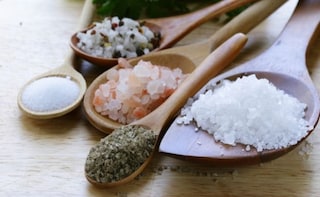You can't live without salt. You don't want to. Salt is the workhorse of the kitchen, the one ingredient in a cook's arsenal that creates magic. The ability of salt to change the taste of food is a marvel. It can dial down bitterness, bring out sweet tones, turn up the volume on natural aromas and make flavours in your food sing.
I always appreciate a slight pinch of salt in my desserts. It gives life to all the nutty flavours. The contrast of mellow, sweet tones and the crispness of salt can hit the right spot. The salty-sweet connection defines indulgence for me. Salt in baked goods can also develop textures.Taste and taste again. A good chef is one who offers a perfect balance of seasonings and salt is one ingredient that sharpens all the other flavours. To make sure, you must add salt in layers and constantly taste your food. If you are adding salt for seasoning and not the above reasons, add it right before serving. That way, salt crystals will hit your palate directly and the flavours will be more impactful.Choose wisely. Your common table salt is one that is fortified with iodine and may contain additives. It is very fine and dissolves the quickest in food, but there's a wide world out there worth salting out. No two salts are the same. You need to master the art, one flake at a time. The three things that you must keep in mind while taking your pick are the intensity of the salt, the nature of its crystals and where to sprinkle.(From rock salt to sea salt, find them all here at affordable prices)Sea Salt: I am huge fan of sea salt, a treasured staple in my kitchen. It is a finisher. Sprinkle it in your salads or over breads. I love to pop a crystal or two with every bite. Sea salt is obtained by evaporating purified sea water at low temperatures. You'll find two types - fine-grind and chunky flakes. It is more intense than the common table salt. Avoid using it in cooking or baking as the big granules don't dissolve easily and may affect the texture
Advertisement
Advertisement
Advertisement
Advertisement
I always appreciate a slight pinch of salt in my desserts. It gives life to all the nutty flavours. The contrast of mellow, sweet tones and the crispness of salt can hit the right spot. The salty-sweet connection defines indulgence for me. Salt in baked goods can also develop textures.Taste and taste again. A good chef is one who offers a perfect balance of seasonings and salt is one ingredient that sharpens all the other flavours. To make sure, you must add salt in layers and constantly taste your food. If you are adding salt for seasoning and not the above reasons, add it right before serving. That way, salt crystals will hit your palate directly and the flavours will be more impactful.Choose wisely. Your common table salt is one that is fortified with iodine and may contain additives. It is very fine and dissolves the quickest in food, but there's a wide world out there worth salting out. No two salts are the same. You need to master the art, one flake at a time. The three things that you must keep in mind while taking your pick are the intensity of the salt, the nature of its crystals and where to sprinkle.(From rock salt to sea salt, find them all here at affordable prices)Sea Salt: I am huge fan of sea salt, a treasured staple in my kitchen. It is a finisher. Sprinkle it in your salads or over breads. I love to pop a crystal or two with every bite. Sea salt is obtained by evaporating purified sea water at low temperatures. You'll find two types - fine-grind and chunky flakes. It is more intense than the common table salt. Avoid using it in cooking or baking as the big granules don't dissolve easily and may affect the texture
For the latest food news, health tips and recipes, like us on Facebook or follow us on Twitter and YouTube.
Advertisement
Tags:
